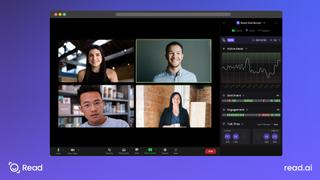New Zoom tool will warn you if you’re boring everyone
Read AI helps you assess the value of your video meetings

A startup has launched a free Zoom tool that it says can assess the quality of video meetings in real-time.
Founded by ex-Foursquare CEO David Shim, Read AI says its goal is to eliminate bad meetings by helping people adapt their approach on the fly.
The company’s tool draws in video and audio data and spits out a color code that shows whether sentiment and engagement levels are good, neutral or bad. This data is presented to all meeting attendees, not just the person who activated the tool.
- Here's our list of the best collaboration tools right now
- Check out our list of the best business webcams around
- We've built a list of the best headsets for conference calls on the market
“As a result of the pandemic, people have been thrown in at the deep end when it comes to video conferencing. There hasn’t been the normal edification process, so people aren’t trained to understand how to read each other over video,” Shim told TechRadar Pro.
“[Using Read] is like looking at your car dashboard to check your speed. It gives you that moment to ask yourself how the call is going and to respond accordingly.”
The tool is currently available to anyone willing to join the waitlist, but is expected to roll out in the official Zoom app store within the coming weeks. The company also says it will aim to bring Read to other popular platforms (like Teams and Meet) soon.
Preventing misuse
Presented with an application that scrutinizes your voice and facial expressions to determine whether you are paying attention, the immediate instinct may be to recoil. However, during our conversation, Shim went out of his way to emphasize that Read is not a surveillance tool.
Are you a pro? Subscribe to our newsletter
Sign up to the TechRadar Pro newsletter to get all the top news, opinion, features and guidance your business needs to succeed!
Instead, he says the company has taken a number of steps to ensure the service is not used to assess individual contributions to meetings and apportion blame, but rather as a means of improving the quality of video meetings.
For example, Read drops a message in the chat at the start of every call to ensure all attendees are aware it is active. If anyone in the lobby is uncomfortable with the idea, they need only type “opt out” into the chat and the tool will be disabled for everyone.
Shim says the company was also careful to ensure data privacy cannot be compromised. Instead of pulling data into its system to improve the performance of its algorithms, Read deletes all data within 24 hours of the end of a call.

Lastly, while the data on engagement and sentiment is drawn from the feeds of each individual attendee, the information is pushed to the dashboard in aggregate, so cannot be used to call out specific people.
It’s worth noting, however, that this is not the case for the talk time metric, which highlights the three most and least dominant speakers on the call. The company says the feature is designed to alert people who may have a habit of speaking over others, but it’s harder to justify the section that exposes the quietest attendees.
Work in progress
The potential value of a tool like Read is clear, giving users a chance to adapt or even end a meeting that isn’t going to plan. However, the implementation leaves something to be desired for now.
For example, the Read interface is currently a little difficult to interpret. With the engagement data broken down into time segments, the ability to draw value from the information hinges on the user remembering what was happening at a particular moment in time.
We also found the very presence of the tool off-putting to an extent. Perhaps this is the kind of thing people will acclimatize to in time, but for now it can be difficult to concentrate on what you’re saying without thinking about how it might manifest in the graph.
However, Shim was quick to note that this is very much the first edition of an evolving product. This is not a tool that will diagnose problems at a granular level, but one designed to help identify high-level trends across multiple meetings.
Over time, he says the company will move towards making more specific recommendations based on the data it collects. But inevitably, an increase in specificity risks compromising all-important anonymity, which is not a trade Shim is eager to make.
- Check out our list of the best VoIP services

Joel Khalili is the News and Features Editor at TechRadar Pro, covering cybersecurity, data privacy, cloud, AI, blockchain, internet infrastructure, 5G, data storage and computing. He's responsible for curating our news content, as well as commissioning and producing features on the technologies that are transforming the way the world does business.
